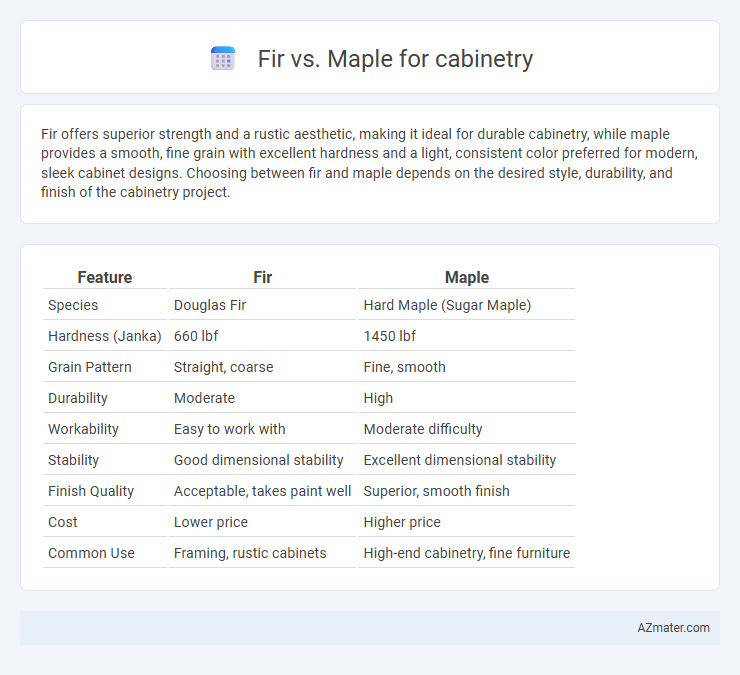Fir offers superior strength and a rustic aesthetic, making it ideal for durable cabinetry, while maple provides a smooth, fine grain with excellent hardness and a light, consistent color preferred for modern, sleek cabinet designs. Choosing between fir and maple depends on the desired style, durability, and finish of the cabinetry project.
Table of Comparison
| Feature | Fir | Maple |
|---|---|---|
| Species | Douglas Fir | Hard Maple (Sugar Maple) |
| Hardness (Janka) | 660 lbf | 1450 lbf |
| Grain Pattern | Straight, coarse | Fine, smooth |
| Durability | Moderate | High |
| Workability | Easy to work with | Moderate difficulty |
| Stability | Good dimensional stability | Excellent dimensional stability |
| Finish Quality | Acceptable, takes paint well | Superior, smooth finish |
| Cost | Lower price | Higher price |
| Common Use | Framing, rustic cabinets | High-end cabinetry, fine furniture |
Fir vs Maple for Cabinetry: Key Differences
Fir wood offers a softer texture and warm, reddish tone, making it ideal for rustic or traditional cabinetry styles, while maple provides a harder, denser grain and a lighter, cream-colored finish suitable for modern or sleek designs. Fir is more affordable and easier to work with but less durable and prone to dents compared to maple, which stands out for its strength, resistance to wear, and smooth surface ideal for staining or painting. The choice between fir and maple for cabinetry largely depends on budget constraints, desired aesthetic, and the level of durability required for the kitchen or storage environment.
Appearance and Grain Patterns in Fir and Maple
Fir wood displays a warm, reddish-brown hue with a straight, prominent grain pattern that adds a rustic and natural charm to cabinetry. Maple offers a lighter, creamy color with a smooth, fine grain that provides a clean, uniform appearance ideal for modern and traditional styles. The distinct grain contrast in fir highlights knots and growth rings, while maple's subtle grain creates a sleek, understated elegance in cabinets.
Durability: Fir Cabinets Compared to Maple
Fir cabinets offer moderate durability with a softer wood grain that is more prone to dents and scratches compared to the dense and hard maple. Maple's high Janka hardness rating around 1450 makes it more resistant to wear and ideal for high-traffic areas or heavy-use cabinetry. Choosing fir may require more careful maintenance, while maple provides a longer-lasting, robust surface for cabinetry applications.
Cost Comparison: Fir vs Maple Cabinetry
Fir cabinetry typically costs less than maple, with fir being a more affordable softwood option that offers decent durability for budget-conscious projects. Maple, a hardwood, generally commands higher prices due to its density, superior hardness, and refined grain, making it a premium choice for long-lasting and high-end cabinetry. Choosing between fir and maple depends on balancing upfront material costs against the desired longevity and aesthetic appeal of the cabinetry.
Workability: Ease of Crafting Fir and Maple Cabinets
Fir offers excellent workability due to its straight grain and softer texture, making it easier to cut, shape, and sand for cabinetry. Maple, being harder and denser, requires sharper tools and more effort but provides a smooth finish that holds detailed carvings and intricate designs well. Woodworkers often prefer fir for quick projects and maple for high-end, durable cabinetry with fine detailing.
Staining and Finishing: Fir vs Maple
Fir offers excellent stain absorption due to its open grain, creating rich, warm tones but may require pre-stain conditioning for uniform results. Maple's dense, tight grain resists staining, often resulting in a blotchy or uneven finish unless sealed or pre-treated. For a smooth, consistent stain on Maple, gel stains or dye-based stains are preferred, whereas Fir allows for more traditional oil or latex-based stains with predictable outcomes.
Environmental Impact: Sustainability of Fir and Maple
Fir and maple are both valued for cabinetry, but their environmental impact varies due to growth rates and harvesting practices. Fir trees grow relatively quickly and can be sourced from sustainably managed plantations, offering a lower carbon footprint compared to slower-growing hardwoods. Maple, especially when sourced locally and certified by organizations like FSC, provides durability with moderate environmental impact due to its longer growth period and the energy required for processing.
Suitability for Styles: Fir vs Maple in Modern and Traditional Kitchens
Fir wood, with its pronounced grain and warm tones, complements traditional kitchen cabinetry, offering a rustic and classic aesthetic that enhances craftsman and farmhouse styles. Maple wood's fine, uniform texture and light, creamy color make it ideal for modern kitchens, providing a sleek, clean look that suits minimalist and contemporary designs. Both fir and maple are durable, but maple's smooth surface allows for easier painting and finishing, making it versatile across various cabinetry styles.
Maintenance and Longevity of Fir and Maple Cabinets
Fir cabinets generally require more frequent maintenance due to their softer wood grain, which is prone to dents and scratches; regular sealing and gentle cleaning help preserve their appearance. Maple cabinets offer superior durability with a harder, denser grain that resists wear and tear, making them a longer-lasting choice with minimal upkeep. Both woods benefit from routine dusting and avoiding harsh chemicals, but maple's natural resilience typically translates into greater longevity and lower maintenance costs over time.
Choosing Between Fir and Maple: Which Is Best for Your Cabinets?
Fir wood offers a softer texture and a warm, reddish tone ideal for rustic cabinetry, while maple provides a harder, more durable surface with a fine, even grain that suits modern, sleek designs. Choosing between fir and maple depends on the desired aesthetic, budget, and usage durability; maple tends to resist dents and scratches better, making it a long-lasting choice for high-traffic kitchens. Consider fir for affordability and natural warmth, and maple when durability and a smooth finish are priorities for cabinetry.

Infographic: Fir vs Maple for Cabinetry
 azmater.com
azmater.com